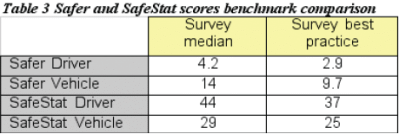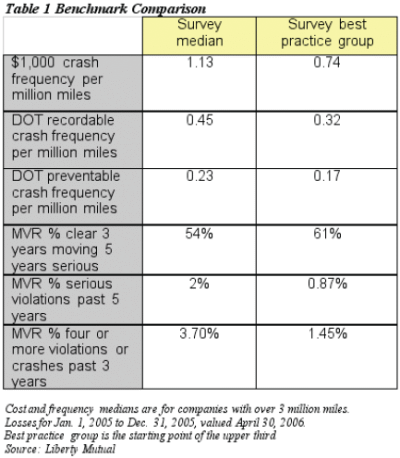The number one way to prevent crashes in fleets: hire high-quality drivers with clear driving records.
In fact, company fleets in which more than 60 percent of drivers hold clear motor vehicle records had a 42 percent lower crash rate than companies with fewer clear drivers. This and other results from a recent survey of 200 trucking operations with more than eight million miles per truck show that companies with the lowest crash rates employ high-quality drivers, enforce performance expectations, monitor driver performance, and place value on maintaining a good safety record.
Driver quality
While there has been a decline in overall driver quality, and a corresponding increase in fleet crash frequency, over the past two years, companies enforcing driver operating guidelines still experienced lower loss ratios.
This article examines what these companies did to achieve above-average loss ratios when the rest of the industry was backsliding. As you read through the results, keep in mind that the survey reviewed trucking companies with more than three million miles of experience. Additionally, only crashes with costs of more than $1,000 were used to measure frequency to remove the impact of low-dollar property damage claims, which are not always reported.
Companies with the best results concentrated on four main program areas associated with lower crash frequency rates and implemented the following.
Driver selection
Overall longer probation periods. Having a probation period of six months or longer –versus three months or less — resulted in a 26 percent lower crash rate.
Probation periods based on driving record.Tailoring probation periods to fit individual driving records, rather than a one-size-fits-all approach, lowered crash rates by 34 percent.
Longer, more extensive road tests. Giving drivers road tests based on their driving records that last two or more hours, with a cargo delivery included in the test, lowered crash rates by 25 percent.
Better-quality drivers. By restricting guidelines so that the median percent of drivers has four or fewer violations/crashes, lowered crash rates 28 percent.
Loss management
Identification on trailers. Even with lower quality drivers, companies with names and phone numbers on their trailers had a 19 percent lower crash frequency.
Road observations. Making frequent road observations reduced crash frequency by 18 percent.
Training identification. Using a system to identify drivers most in need of training or management attention resulted in a 29 percent lower crash rate.
Driver policies
Governor speed settings. With governors set below 68, companies reduced crash frequency by 17 percent.
Following distance. Implementing a following distance policy of six to eight seconds between vehicles or slightly slower than the flow in heavy traffic reduced crash rates by 25 percent.
Driver training
In-vehicle training. Providing in-vehicle training for new drivers lowered crash rates by 15 percent even with lower driver quality.
Skid pan training. With a 46 percent lower crash rate, it is well worth the effort to use skid pan training when available.
One-on-one training. Using individual, rather than group training works well with drivers, delivering a crash rate 29 to 42 percent lower than the median.
Post crash in-vehicle training. Giving drivers in-vehicle training after a crash reduced crash rates by 29 percent.
Other strategies the companies with best results in the survey implemented that delivered measurable results include:
- Provided drivers with cameras and written crash scene instructions.
- Maintained a crash database or spread sheet.
- Equipped all drivers with route plans.
- Downloaded electronic control module data each time a vehicle is serviced.
- Documented all safety-related contacts with the company’s drivers.
- Provided written training outlines and training meeting agendas.
- Used electronic control module data to identify drivers needing training or management attention.
- Scheduled departure times.
- Established mirror check stations.
- Equipped tractors with right and left side fender mirrors.
Table 1 on page N24 illustrates median survey results versus the results of the surveyed best practice group.
Safer and SafeStat
Another possible vehicle for reducing crash frequency is a regular review of Safer and SafeStat scores. While the survey Table 2 on page N24 shows relationships between lower crash rates and Safer and SafeStat scores, there were still exceptions to this finding, which make it not as reliable as driver training. The Safer and SafeStat scores were also compared to the $1,000 crash frequency.

Specifically addressing areas such as driver selection, policies and performance monitoring can help lower crash rates and Safer/SafeStat scores. See Table 3 above.
Management matters
The most important component to all best practices is management involvement. Because crash rates are significantly impacted by the way a trucking company is managed, expectations for the company, the driver managers and drivers must be established and communicated. Policies should address both safe driving habits and behaviors that contribute to crashes through clearly written — and enforceable — communications. Follow up by measuring performance against the written policies and immediately work to change behaviors that do not contribute to the overall goals.
Adopting best practices and maintaining high driver selection standards will help make your operation safer, keep your drivers happy and improve the bottom line.
Pete Van Dyne, technical director of transportation for Liberty Mutual Group, can be reached at 262-782-9500 x350 or via e-mail at peter.vandyne@libertymutual.com.
Topics Auto Trucking Training Development
Was this article valuable?
Here are more articles you may enjoy.




 Chubb to Acquire MGA Healthy Paws From Aon
Chubb to Acquire MGA Healthy Paws From Aon  Supreme Court Makes It Easier to Sue for Job Discrimination
Supreme Court Makes It Easier to Sue for Job Discrimination  Wildfires Are Upending Some of the Safest Bets on Wall Street
Wildfires Are Upending Some of the Safest Bets on Wall Street  Uncertainty Keeps Prices Up; No Prior-Year Loss Development: Travelers
Uncertainty Keeps Prices Up; No Prior-Year Loss Development: Travelers 


